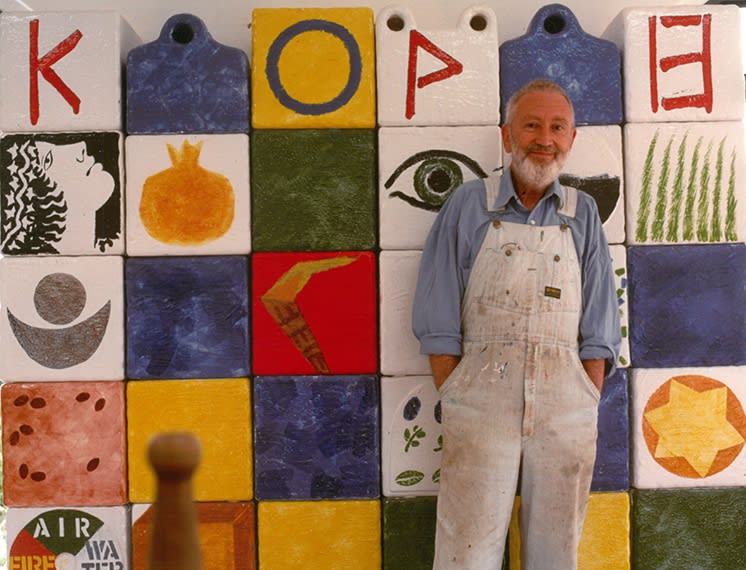Joe Tilson was born in London in 1928. From 1944 to 1946 he worked as a carpenter and cabinet maker then served his National Service in the R.A.F. between 1946 and 1949. After leaving military service he returned to London and from 1949 to 1952 he studied at St Martin's School of Art alongside Leon Kossoff and Frank Auerbach. From 1952 to 1955 Tilson's studies continued at the Royal College of Art where he met Peter Blake, Allen Jones, Patrick Caulfield and David Hockney, who along with Tilson, were founding figures in the British Pop Art movement. In 1955 the Royal College awarded Tilson the Rome Prize which allowed him to live and work in Italy which introduced him to its classical history and culture. Italy is a country from which Tilson has drawn a lifetime of inspiration. Tilson returned to England in 1957 and took up teaching positions over the next five years at St Martin's School of Art and the Slade School of Fine Art before travelling to New York to teach at The School of Visual Arts. Tilson has also taught at University College London, Kings College in Newcastle upon Tyne and the Hochschule für Bildende Künste in Hamburg.
Tilson's early work was in a realist style but this was followed by Arte Povera which he had seen in Italy. During the emergence of Pop Art in the 1960s he developed his idiosyncratic style. Tilson's bold and often humorous artworks were painted, collaged and carved constructions and reliefs that freely incorporated textiles, plastic and photography. In the later 1960s he began to move away from celebrating the contemporary fashions and issues of the decade. He gravitated towards Greek mythology, ancient cultures such as those of the Indigenous Peoples of the Americas and Australia, lunar cycles and Neo-Platonic theory. Tilson's unique works might be conventional painted canvases and panels, or works in wood, ceramic or stone using other natural materials such as straw or rope. These artworks can be in the form of boxes, ladders, standing totems or other objects. Tilson has also been a prolific printmaker using an enormous range of techniques.
Tilson's first one-man shows were held at the Marlborough Gallery, London in 1962 and at the Walker Art Gallery, Liverpool in 1963. After winning the Gulbenkian Foundation Award in 1960, he represented Britain at the 32nd Venice Biennale in 1964 and this gained him his first international exposure. This led to his first retrospective which was held at the Museum Boijmans van Beuningen, Rotterdam in 1964, and others followed at the Vancouver Art Gallery in 1979, the Arnolfini Gallery, Bristol in 1984, a major retrospective 'Joe Tilson: Pop to Present' at the Royal Academy, London in 2002, and the Palazzo Doria, Loano, Savona, Italy in 2007. Tilson has continued to exhibit regularly in solo shows throughout the world. His work was also included in 'Art & The 60s: This Was Tomorrow', Tate Britain, London in 2004 and 'Eye on Europe', MOMA, New York in 2006. Tilson's work is held in many art collections including the Tate, London; Victoria and Albert Museum, London; Walker Art Gallery, Liverpool; The Calouste Gulbenkian Foundation, Lisbon; Galleria Nazionale d Arte Moderna, Rome; Stedelijk Museum, Amsterdam; Museum of Modern Art, New York; Yale Centre for British Art, Connecticut; Walker Art Center, Minneapolis and the Kunsthalle Basel, amongst others.
Tilson was elected a Royal Academician in 1991 and lives and works in London, England and Cortona, Italy.

